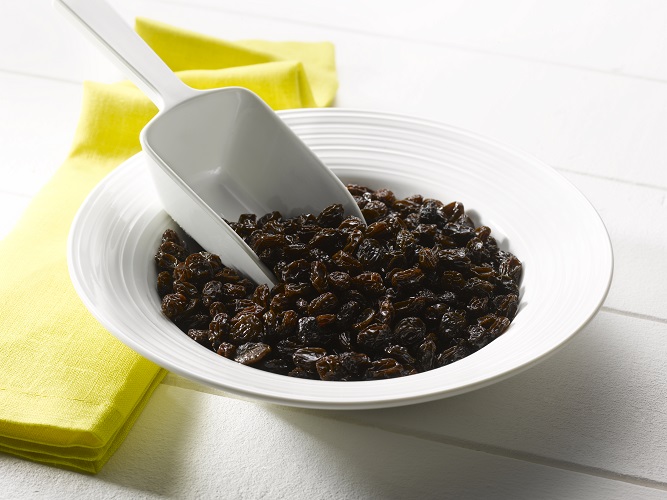When it’s a sultana, for years people have often confused the two, it’s fair to say that they are both dried grapes but that is where the similarities end. It’s like comparing a Cox apple with a Golden Delicious…. but both are of course apples.
 California is the world’s largest producer of raisins. California raisins are produced from the Thompson seedless grape, in fact the California raisin was ‘invented’ by William Thompson in 1876 when he crossed the Lady de Coverley grape with other varieties to produce a seedless grape, perfect for producing raisins.
California is the world’s largest producer of raisins. California raisins are produced from the Thompson seedless grape, in fact the California raisin was ‘invented’ by William Thompson in 1876 when he crossed the Lady de Coverley grape with other varieties to produce a seedless grape, perfect for producing raisins.

As the term suggests, sun dried California raisins use natural sunlight to produce raisins and take up to 3 weeks in the hot California sun to produce what is commonly referred to as a maillard effect. During sun drying the skin of the raisin acts as a ‘cooking vessel’ retaining the juices inside and helps convert some of the sugars to primary elements. This effect also produces a rich, caramel flavour.
Apart from an obvious distinction in colour, California raisins are known for their dark, rich taste making them ideal for a whole range of applications from snacking, through baking, sauces, fine dining and even beer.
Sultanas also belong to the same grape family (Vitaceae) and are native to the Caspian Sea, Turkey is the world’s largest producer of sultanas. Sultanas are often referred to as ‘White Raisins’, the sultana differs from the true raisin in two ways. Firstly, and most apparent, it is much lighter in colour, although the colour ranges from very light to dark brown, but more importantly, it undergoes a different drying process.
Increasingly Thompson seedless grapes have been grown to produce seedless sultanas. During the drying process, the mature grapes are dipped in a potash solution making the skins supple and helps reduce the drying process. The drying period for sultanas lasts approximately 10-14 days as opposed to around 3 weeks to produce a raisin.
Sultanas tend to be slightly sweeter than raisins quite simply because the effects of sun drying are much less pronounced, so the sultana retains a lot of its original sugars.
Often sultanas and raisins are confused with each other, some people refer to them as ‘sultana raisins’ adding to the existing confusion.
Most of the UK trade and buyers understand the differences and market sultanas and raisins as different products, this is an important distinction to make since the UK market is not only the largest in the world for dried vine fruit at 106,116MT in 2016, but it is growing. Moreover, raisins and sultanas account for 95% of this total.
It is important to make the distinction between sultanas and raisins, not only because they are different end products, but because distinction creates separate profit opportunities for retailers and buyers. This is particularly important when increasingly, customers are not only wanting to know what the product is that they are buying but also where it comes from.
California provides piece of mind for buyers and customers by consistently producing a clean, safe, rich tasting product from the world’s foremost raisin producing region.
THE FACTS AND FIGURES
Guaranteed Quality
California Raisins are a clean, quality assured product from the US
- California Raisins are grown and processed to meet high USDA standards
- California Raisins are the best value dried fruit
- California Raisins can be custom packed to meet many varied company’s requirements.
Natural Sweetness
California Raisin growers pick Natural Seedless grapes when they have a high Brix Level at 20degrees to 23 degrees, at the very peak of ripeness. When dried, California Raisins contain natural fruit sugars and are plump and chewy and do not require sugar infusions.
Natural Colour
California Raisins are naturally brown due to the Mallard reaction that occurs after picking and as they dry. This appealing dark colour is fixed and will not bleed or discolour food products. No artificial food colorants or additives are used in the production of California Raisins.
APPLICATONS
- Extends the shelf-life of bread products
- Sweetens and colours natural baked goods
- Natural preservative
- Sugar substitute
- Filling for sweets and moulded chocolates
- Controls breakage in crisp cookies and crackers
- Maintains moisture in chewy cakes
- Natural binding agent in cereal bars
- Natural syrup for yogurts and ice cream
- Enhances the colour and flavour of chocolate milk and ice cream
- Enhances the flavours of sauces
- Natural colouring agent.




Comments are closed.